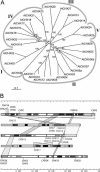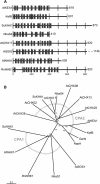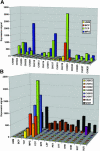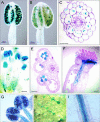Expression patterns of a novel AtCHX gene family highlight potential roles in osmotic adjustment and K+ homeostasis in pollen development
- PMID: 15347787
- PMCID: PMC523320
- DOI: 10.1104/pp.104.046003
Expression patterns of a novel AtCHX gene family highlight potential roles in osmotic adjustment and K+ homeostasis in pollen development
Abstract
A combined bioinformatic and experimental approach is being used to uncover the functions of a novel family of cation/H(+) exchanger (CHX) genes in plants using Arabidopsis as a model. The predicted protein (85-95 kD) of 28 AtCHX genes after revision consists of an amino-terminal domain with 10 to 12 transmembrane spans (approximately 440 residues) and a hydrophilic domain of approximately 360 residues at the carboxyl end, which is proposed to have regulatory roles. The hydrophobic, but not the hydrophilic, domain of plant CHX is remarkably similar to monovalent cation/proton antiporter-2 (CPA2) proteins, especially yeast (Saccharomyces cerevisiae) KHA1 and Synechocystis NhaS4. Reports of characterized fungal and prokaryotic CPA2 indicate that they have various transport modes, including K(+)/H(+) (KHA1), Na(+)/H(+)-K(+) (GerN) antiport, and ligand-gated ion channel (KefC). The expression pattern of AtCHX genes was determined by reverse transcription PCR, promoter-driven beta-glucuronidase expression in transgenic plants, and Affymetrix ATH1 genome arrays. Results show that 18 genes are specifically or preferentially expressed in the male gametophyte, and six genes are highly expressed in sporophytic tissues. Microarray data revealed that several AtCHX genes were developmentally regulated during microgametogenesis. An exciting idea is that CHX proteins allow osmotic adjustment and K(+) homeostasis as mature pollen desiccates and then rehydrates at germination. The multiplicity of CHX-like genes is conserved in higher plants but is not found in animals. Only 17 genes, OsCHX01 to OsCHX17, were identified in rice (Oryza sativa) subsp. japonica, suggesting diversification of CHX in Arabidopsis. These results reveal a novel CHX gene family in flowering plants with potential functions in pollen development, germination, and tube growth.
Figures







References
-
- Ali R, Brett CL, Mukherjee S, Rao R (2004) Inhibition of sodium/proton exchange by a Rab-GTPase-activating protein regulates endosomal traffic in yeast. J Biol Chem 279: 4498–4506 - PubMed
-
- Apse MP, Aharon GS, Snedden WA, Blumwald E (1999) Salt tolerance conferred by overexpression of a vacuolar Na+/H+ antiport in Arabidopsis. Science 285: 1256–1258 - PubMed
-
- Arabidopsis Genome Initiative (2000) Analysis of the genome sequence of the flowering plant Arabidopsis thaliana. Nature 408: 796–815 - PubMed
Publication types
MeSH terms
Substances
LinkOut - more resources
Full Text Sources
Other Literature Sources
Molecular Biology Databases

